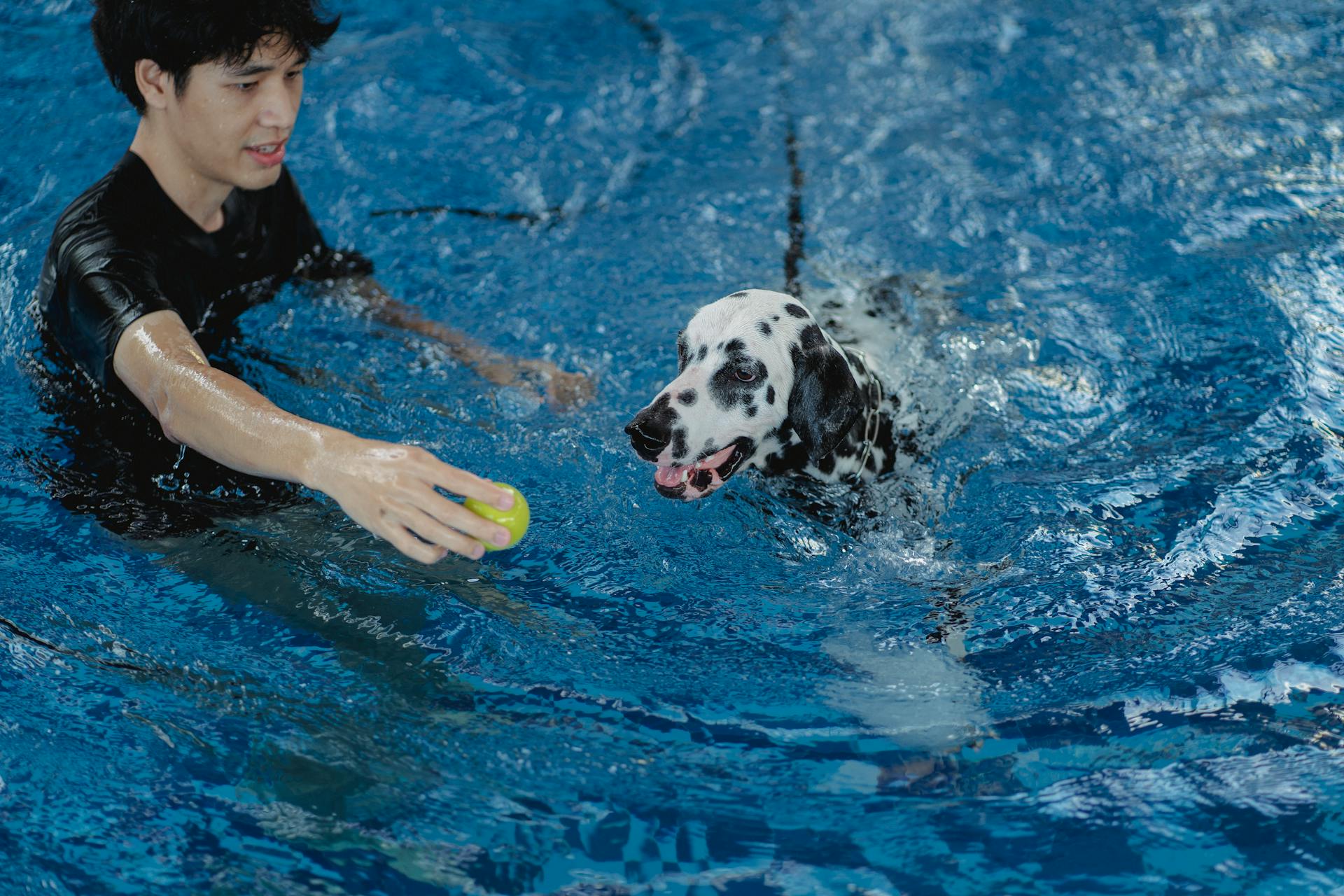
Pheasant scent dog training is a unique and rewarding experience for both you and your dog. The key to success lies in understanding the basics and best practices of this specialized training.
To start, you'll need a dog with a strong nose and a keen instinct for hunting. Pheasants have a distinct scent that dogs can pick up on, and with the right training, your dog can learn to follow that scent and track down the birds.
The most effective training method for pheasant scent dogs is positive reinforcement training, which focuses on rewarding good behavior rather than punishing bad behavior. This approach helps to build trust and confidence between you and your dog.
In the early stages of training, it's essential to use high-value rewards to motivate your dog and keep them engaged. This can be anything from treats to praise and affection.
Related reading: Pheasant Dog Training
What is a Pheasant Scent Dog?
A pheasant scent dog is a highly trained dog that uses its incredible sense of smell to locate and point pheasants.
Pheasant scent dogs are often used by hunters to locate hidden birds, and they can be trained to work in a variety of environments.
These dogs have an extremely sensitive nose, with some capable of detecting scents that are up to 10,000 times weaker than what a human can detect.
Their keen sense of smell is due to the large number of olfactory receptors in their noses, which allows them to pick up on subtle scents that might be missed by other dogs.
A good pheasant scent dog can be trained to work in a variety of conditions, from dense forests to open fields.
Their ability to locate pheasants is due in part to their ability to follow the scent of the birds, which can be left behind on vegetation, rocks, and other objects.
If this caught your attention, see: Can You Train Chihuahuas
Upland Bird Hunting
Upland bird hunting requires a combination of where the bird is and possibly has been. Upland birds will move around when you get in the area, so the dog needs to be smart enough to find scent and determine if it's where the bird was or is.
Suggestion: Training a Bird Dog
Training for upland birds can be done with training bumpers and dummies, but there's really no replacement for training with live birds. Live birds provide the most realistic scent for the dog to follow.
Some trainers use pigeons to train young dogs because pigeons are smelly birds that allow dogs to pick up their scent quickly. Pigeons are a good substitute for game birds when live birds are not available.
Using a liquid scent and giving the pigeon a quick shower in scent can help train the dog for the game bird you're going to be hunting. This is especially helpful for grouse training, as finding grouse to train with is hard and expensive.
Most trainers start with pigeons and then work their way to quail and chukar, which can be inexpensive and are hearty training birds.
Curious to learn more? Check out: Are Goldendoodles Easy to Train
Training Equipment
Training Equipment is an essential part of pheasant scent dog training. It's what helps your dog learn to track and retrieve game birds.
Bumpers are a common type of training equipment used for pheasant scent dog training. They come in different forms, sizes, and styles to meet your training needs.
Training bumpers can be used for short retrieves, blind retrieves, and launched retrieves. They're designed to be the relative size and weight of a game bird to train your dog as realistically as possible.
Canvas bumpers allow for injecting scent directly into the body of the bumper. This makes them a good option for training your dog to follow a scent trail.
Rubber and plastic bumpers will have scent applied to the outside of the bumper. This type of bumper is still effective for training, but it may not be as realistic as a canvas bumper.
If you're unsure about which bumper to choose, consider your training goals and the needs of your dog.
A unique perspective: Bumpers for Dog Training
Training Basics
To start training your pheasant scent dog, it's essential to establish a strong foundation in obedience and basic scent work.
Begin by teaching your dog to focus on you in distracting environments, such as a busy park or a field with other birds.
Start with short training sessions of 10-15 minutes, gradually increasing the duration as your dog becomes more focused.
Use high-value rewards like treats and praise to reinforce good behavior, and be consistent in your commands and hand signals.
Pheasants have a strong instinct to follow their natural scent, so introduce your dog to pheasant scent articles, such as a piece of cloth or a scent cloth, to help them develop their tracking skills.
Begin by hiding the scent article in plain sight, then gradually move it to more challenging locations, such as under a bush or behind a tree.
As your dog becomes more confident in their tracking abilities, you can start to introduce distractions, such as other animals or people, to help them learn to focus on the scent.
Remember to always end training sessions on a positive note, while your dog is still engaged and motivated.
Explore further: Healthy Mind Canine - Separation Anxiety Training
Frequently Asked Questions
What is the best scent training for dogs?
For scent training, popular scents like birch, anise, and clove are commonly used to engage and challenge dogs. Pairing these scents with food or toys can make training a fun and rewarding experience for your dog.
Sources
- https://www.frontrangegundog.com/product/pheasant-scent/
- https://www.lcsupply.com/blogs/hunting-dog-supplies-reviews/how-to-scent-train-your-dog
- https://www.overtons.com/dokken-dog-training-scent-wax-pheasant-311764.html
- http://gundogforum.com/forum/viewtopic.php
- https://www.gundogstore.eu/dog-training/pheasant-scent-35ml/
Featured Images: pexels.com


